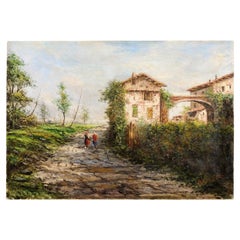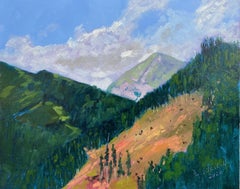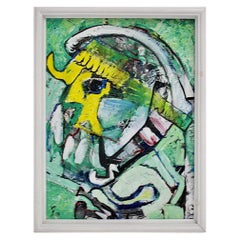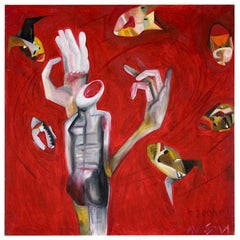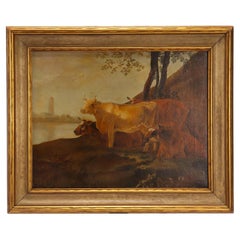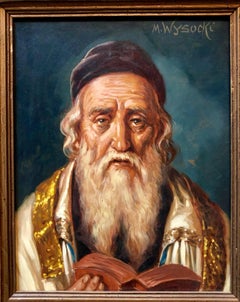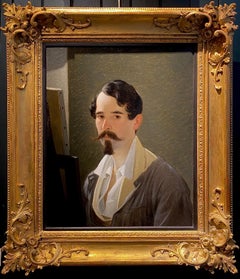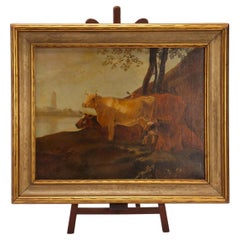Austrian Oil Painting
Antique 19th Century Austrian Paintings
Canvas, Paint
Antique 19th Century Austrian Paintings
Canvas, Paint
21st Century and Contemporary Impressionist Paintings
Oil
1990s Austrian Modern Paintings
Natural Fiber
Early 2000s Austrian Modern Paintings
Canvas
Antique 1880s Austrian Paintings
Canvas, Fruitwood
20th Century Realist Portrait Paintings
Oil, Panel
1860s Vienna Secession Portrait Paintings
Oil
Antique Late 19th Century Austrian Paintings
Canvas, Wood
20th Century Victorian Portrait Paintings
Board, Oil
Vintage 1960s Austrian Mid-Century Modern Paintings
Natural Fiber
Early 20th Century Academic Portrait Paintings
Oil
Vintage 1930s Austrian Modern Paintings
Canvas
1930s Naturalistic Portrait Paintings
Oil, Wood Panel
20th Century Modern Landscape Paintings
Oil, Canvas
Early 20th Century Austrian Romantic Paintings
Paint
Early 20th Century Austrian Paintings
Canvas, Wood
20th Century Modern Figurative Paintings
Canvas, Oil
19th Century Victorian Portrait Paintings
Oil
1940s Realist Landscape Paintings
Oil, Panel
Antique Late 19th Century Austrian Paintings
Canvas
20th Century Austrian Paintings
Canvas
Mid-20th Century Post-Impressionist Portrait Paintings
Oil
2010s Modern Paintings
Oil
2010s Modern Paintings
Oil
Vintage 1930s Austrian Art Deco Paintings
Canvas
2010s Modern Paintings
Oil
Early 20th Century Figurative Paintings
Oil
19th Century Romantic Landscape Paintings
Canvas, Wood, Oil
Joseph BrunnerJ. Brunner 1869 Oil on Canvas Austrian Landscape with Lake and Mountain Painting, 1869
Antique Late 19th Century Austrian Paintings
Paint, Canvas, Wood
1870s Romantic Figurative Paintings
Gesso, Oil, Board
Antique 19th Century Austrian Barbizon School Paintings
Canvas, Wood, Paint
Mid-20th Century German Biedermeier Paintings
Canvas, Wood
19th Century Portrait Paintings
Oil
Mid-19th Century Romantic Landscape Paintings
Oil
1870s Realist Landscape Paintings
Canvas, Oil
Mid-20th Century Figurative Paintings
Canvas, Oil
Mid-19th Century Romantic Landscape Paintings
Canvas, Oil
2010s Impressionist Paintings
Oil
1880s Romantic Portrait Paintings
Oil, Canvas
Antique Late 19th Century Austrian Paintings
Paint
Early 1900s Realist Animal Paintings
Canvas, Oil
2010s Abstract Geometric Abstract Paintings
Cotton Canvas, Oil
Early 1900s Impressionist Landscape Paintings
Linen, Oil, Wood
2010s Contemporary Abstract Paintings
Canvas, Oil
Late 19th Century Figurative Paintings
Canvas, Oil
Antique 19th Century Austrian Rococo Paintings
Gesso, Wood
Early 20th Century Realist Landscape Paintings
Canvas, Wood, Cotton Canvas, Oil
20th Century Figurative Paintings
Canvas, Oil
1920s Impressionist Landscape Paintings
Canvas, Oil, Wood
Antique Early 1900s Austrian Folk Art Paintings
Canvas, Giltwood
19th Century Victorian Interior Paintings
Paper, Oil
1930s Portrait Paintings
Oil
2010s Abstract Geometric Abstract Paintings
Cotton Canvas, Oil
2010s Abstract Geometric Abstract Paintings
Cotton Canvas, Oil
Antique 1880s Austrian Belle Époque Paintings
Wood, Giltwood
2010s Expressionist Nude Paintings
Oil, Canvas
2010s Contemporary Abstract Paintings
Canvas, Oil
Early 2000s Contemporary Abstract Paintings
Canvas, Acrylic
2010s Contemporary Abstract Paintings
Cotton Canvas, Oil
- 1
- ...
Austrian Oil Painting For Sale on 1stDibs
How Much is an Austrian Oil Painting?
- Lilac Gallery Ltd.March 18, 2021The cost of an original oil painting has a very wide range. For emerging new artist could be in the lower end, ranging from the $500 to $10,000 depending on the size and subject matter, for the mid-career artists who are already established, their prices range in the thousands and hundreds of thousands of dollars and lastly the original oil painting art of very established and popular artists that could have auction records in the millions of dollars. In this category are some of the well known examples of the old master paintings and other contemporary artworks.
- 1stDibs ExpertApril 5, 2022To tell if your oil painting is authentic, first check the signature of the artist to start your research. Use a magnifying glass to check the texture of the painting, and finally check the back for the painting’s original stretchers. Shop a selection of expertly vetted artwork from some of the world’s top art dealers on 1stDibs.
- 1stDibs ExpertFebruary 13, 2024To identify an oil painting, look closely at its surface. Compared to other paintings, pieces produced in oils usually show off a variety of textures across the canvas, and the paint will appear layered on. If you're looking to determine the name, age or creator of a work, try snapping a photo with your smartphone’s camera and conducting a reverse image search online. Shop a diverse assortment of oil paintings on 1stDibs.
- When was oil paint invented?1 Answer1stDibs ExpertFebruary 27, 2024Oil paint was invented during the 7th century A.D. The earliest examples of oil paintings have been traced to Afghanistan and depict scenes related to the Buddhist religion. Records dating back to the 12th century indicate that early Christian monks in Europe used oil paints to decorate furniture, and a century later, some artists began finishing tempera paintings with touches of oil paint. It wasn't until the 15th century that oil paints became a common medium for European painters, when Flemish artists like Jan van Eyck began favoring them over tempera. Explore a variety of oil paintings on 1stDibs.
- 1stDibs ExpertMay 3, 2024Jan van Eyck is widely considered by art historians to be the father of oil painting. While the usage of oil paints dates back to 7th-century China, the Flemish painter popularized the material, using oils to produce highly detailed works such as The Arnolfini Portrait. The Northern Renaissance master also influenced many other artists, such as Hugo van der Goes and Gerard David. Shop an assortment of fine art on 1stDibs.
- What is abstract oil painting?1 AnswerLilac Gallery Ltd.March 17, 2021An abstract oil painting and an artwork that is made with oil paint on a medium like canvas, wood board, or other panels like canvas board. And the 'abstract' term refers to the Movement & Style of the piece. As abstraction indicates a departure from reality in the depiction of imagery in art, the artist creates a painting where the subject, shape, form, color, and line, is created with no particular references of the world but as a composition that may exist with a degree of independence from its vision.
- 1stDibs ExpertMarch 22, 2024To maintain oil paintings that you purchased for your home, experts suggest that you keep them out of direct sunlight. Prolonged exposure to the sunlight coming in from a window can fade the colors in your painting. Do not hang your oil painting near a heat source or where it can get wet (bathrooms and kitchens are not safe for your oil painting).
You may wish to dust your oil painting so that layers of dust don’t begin to gather on its surface. This should only be considered to remove loose dust. Never spray any chemical substance on your oil painting. Do not use a damp cloth to dust your oil painting. (Again, your painting should not be exposed to moisture.)
To remove loose dust, use a soft brush that measures approximately one to two inches wide with natural-hair bristles. Do not use a dust cloth or a feather duster, as those items may catch or leave threads or feathers behind. Do not apply pressure or dust your painting for an extended period of time.
If you think that your oil painting is considerably dirty or believe that other issues may be at work, experts strongly suggest that you consult with a professional conservator.
Read about how to arrange your wall art and find oil paintings for sale on 1stDibs. - Did Dali use oil paint?1 Answer1stDibs ExpertApril 5, 2022Yes, Dali did indeed use oil paint. Although he used oil paints in the traditional method, he would at times add natural resin or linseed oil to play with fluidity and texture. You can shop a selection of Salvador Dali’s pieces from some of the world’s top art dealers on 1stDibs.
- Can you use oil paint on wood?1 Answer1stDibs ExpertFebruary 22, 2021You can use oil paint on wood as long as you prep the wood first. The first thing you should do is seal the wood with a primer. Ideally, paint two coats of sealer onto the wood so that the paint doesn't cause the wood to rot over time.
- 1stDibs ExpertApril 5, 2022The largest oil painting in the world is in the main hall of the Doge's Palace located in Venice, Italy. Its name is Il Paradiso. Tintoretto painted it around 1592, and it measures 22 meters by 7 meters. Shop a large collection of oil paintings on 1stDibs.
- 1stDibs ExpertSeptember 25, 2019
Varnishing an oil is not necessary, but it is recommended because it protects the painting and corrects surface irregularities.
- 1stDibs ExpertApril 5, 2022To find the artist of an oil painting, look on the back of the canvas. Sometimes, you will find the artist’s name and the year of production on the back. If the canvas is in a frame, gently peel away the paper covering the back to access the canvas. In the event you cannot find any identifying information, seek the help of a licensed art appraiser. Shop a selection of oil paintings on 1stDibs.
- La ChrysomeleFebruary 24, 2021Any artwork is worth and only worth the price someone is willing to pay for it (unfortunately, whether one can afford it or not is another story). Different people may have different reasons to attribute value to an artwork, from the purest (falling in love with it) to what is often considered as the most vile (speculation), going through remembrance, pride of ownership, or brag, among other reasons. For most living artists, the price of the artworks is usually set by the artist and/or the gallery which represent him or her, by type and size of artwork, and corresponds to an equilibrium price between the rate at which artworks are sold and the rate at which new artworks are produced by the artist. For artworks from dead artists sold by professional dealers, the price is often based on auctions results for similar pieces of the same artists. Oil paintings are usually pricier than other techniques because it is considered more difficult to master, but also because oil paintings are known for their ability to last centuries.
- 1stDibs ExpertFebruary 13, 2023Because the value of an oil painting can vary greatly based on the artist, the subject and the condition of the piece, it's generally best to work with a certified appraiser. A knowledgeable professional can evaluate the piece and estimate its value. Shop a variety of authentic oil paintings from some of the world’s top galleries on 1stDibs.
- 1stDibs ExpertApril 5, 2022The best place to find oil paintings and discover new artists is at local art galleries. There are also many online art dealers who provide information about artists and sell their works. On 1stDibs, you’ll discover a variety of art styles from master oil painters.
- 1stDibs ExpertMarch 22, 2024Yes, sunlight affects oil paintings. Keep your oil paintings away from direct sunlight.
To maintain oil paintings that you purchased for your home, experts suggest that you keep them out of sunlight. Prolonged exposure to the sunlight coming in from a window can fade the colors in your painting. Do not hang your oil painting near a heat source or where it can get wet (bathrooms and kitchens are not safe for your oil painting).
You may wish to dust your oil painting so that layers of dust don’t begin to gather on its surface. This should only be considered to remove loose dust. Never spray any chemical substance on your oil painting. Do not use a damp cloth to dust your oil painting. (Again, your painting should not be exposed to moisture.)
To remove loose dust, use a soft brush that measures approximately one to two inches wide with natural-hair bristles. Do not use a dust cloth or a feather duster, as those items may catch or leave threads or feathers behind. Do not apply pressure or dust your painting for an extended period of time.
If you think that your oil painting is considerably dirty or believe that other issues may be at work, experts strongly suggest that you consult with a professional conservator.
Read about how to arrange your wall art and find oil paintings for sale on 1stDibs. - How much do oil paintings cost?1 Answer1stDibs ExpertSeptember 25, 2019
On 1stdibs, oil paintings cost between $60 and $6,200,000.
- 1stDibs ExpertMarch 22, 2024Yes, oil paintings darken over time. As oil paint is made of pigment particles, the range of substances that are used as pigment in oil paint can render certain colors susceptible to aging. Slowing the aging process for an oil painting involves storing your painting properly and keeping the work out of exposed sunlight. Temperature control and humidity are also important in preserving the life of an oil painting and slowing the aging process.
To maintain oil paintings that you purchased for your home, experts suggest that you keep them out of direct sunlight. Prolonged exposure to the sunlight coming in from a window can fade the colors in your painting. Do not hang your oil painting near a heat source or where it can get wet (bathrooms and kitchens are not safe for your oil painting).
You may wish to dust your oil painting so that layers of dust don’t begin to gather on its surface. This should only be considered to remove loose dust. Never spray any chemical substance on your oil painting. Do not use a damp cloth to dust your oil painting. (Again, your painting should not be exposed to moisture.)
To remove loose dust, use a soft brush that measures approximately one to two inches wide with natural-hair bristles. Do not use a dust cloth or a feather duster, as those items may catch or leave threads or feathers behind. Do not apply pressure or dust your painting for an extended period of time.
If you think that your oil painting is considerably dirty or believe that other issues may be at work, experts strongly suggest that you consult with a professional conservator.
Read about how to arrange your wall art and find oil paintings for sale on 1stDibs. - 1stDibs ExpertMay 3, 2024A few things make an oil painting valuable. Age has a major impact on price, with pieces made over a century ago tending to fetch the highest prices. Who created the painting also matters. The more famous the artist, the higher the selling price for a painting is likely to be. Finally, the condition of the work and whether it is in its original frame will also impact how much it is worth. Find a diverse assortment of oil paintings on 1stDibs.
- 1stDibs ExpertSeptember 25, 2019
Oils typically command higher prices than acrylic paintings, because they generally require more skill.
- 1stDibs ExpertApril 12, 2024Who made the largest oil painting in the world changes over time. While working in Valencia, Venezuela, in 2022, Italian artist Francesco Santoro created a work that is 2,033.84 square feet in size. It was used in the repair of a church that was damaged by an earthquake. Find a wide range of oil paintings on 1stDibs.
- Did Cy Twombly use oil paint?1 Answer1stDibs ExpertApril 5, 2022Yes, Cy Twombly did use oil paint, although his method was quite unique. He would run his fingers in the paint to create channels, and would then use oil paint in ‘globs’. House paint overtop would then merge the paints into a completed piece. Shop a selection of Cy Twombly’s pieces from some of the world’s top art dealers on 1stDibs.
Read More
Art Brings the Drama in These Intriguing 1stDibs 50 Spaces
The world’s top designers explain how they display art to elicit the natural (and supernatural) energy of home interiors.
Welcome (Back) to the Wild, Wonderful World of Walasse Ting
Americans are rediscovering the globe-trotting painter and poet, who was connected to all sorts of art movements across a long and varied career.
In Francks Deceus’s ‘Mumbo Jumbo #5,’ the Black Experience Is . . . Complicated
Despite the obstacles, the piece’s protagonist navigates the chaos without losing his humanity.
With Works Like ‘Yours Truly,’ Arthur Dove Pioneered Abstract Art in America
New York gallery Hirschl & Adler is exhibiting the bold composition by Dove — who’s hailed as the first American abstract painter — at this year’s Winter Show.
Donald Martiny’s Jumbo Brushstrokes Magnify the Undeniable Personality of Paint
How can a few simple gestures — writ extra, extra, extra large — contain so much beauty and drama?
Patrick Hughes’s 3D Painting Takes Us on a Magical Journey through Pop Art History
The illusions — and allusions — never end in this mind-boggling portrayal of an all-star Pop art show on a beach.
Mid-Century Americans Didn’t Know Antonio Petruccelli’s Name, but They Sure Knew His Art
The New York artist created covers for the nation’s most illustrious magazines. Now, the originals are on display as fine art.
Learn Why There Have Been So Many Great Women Painters
Featuring iconic works by more than 300 female artists, a new book makes a more than compelling case for casting off the patriarchal handcuffs that have bound the art historical canon for far too long.

